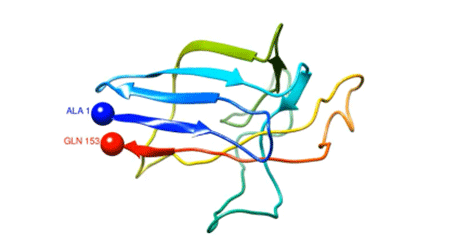Virtual experiment pulls apart proteins to observe nano-glass

PHAS researchers Mona Habibi, Steve Plotkin, and Joerg Rottler pulled apart proteins to dissect their internal forces. Results from their study has been published in a recent issue of the Biophysical Journal.
A protein is a linear chain of amino acids made up of about a couple thousand atoms, all of which are fluctuating around furiously in our bodies because our cells are full of thermal energy. However, the atoms in a protein are still being held together amidst this chaotic motion by internal forces inside the protein. In this study, Habibi et al found that a protein is in fact made up a composite of soft and rigid regions, and that where these regions are can be discovered by taking the protein in the absence of any thermal energy, and "pinging" it like a tuning fork to see how it vibrates. The vibrations disperse all over the protein in a complicated way, but the rigid parts vibrate quickly when pinged, and the soft parts vibrate slowly when pinged.
This study was done in the virtual environment of a computer simulation, allowing the group to go further in the analysis of how the protein unravels. "We use the strength of computer simulation to perform analysis similar to what experimental spectroscopists do in much larger, condensed matter systems," said Plotkin. "It is possible in principle to experimentally get at the quantities we have been measuring, but several experiments would be needed with several protein labels; these experiments haven't been done yet."
If a protein is grabbed by the ends and gradually pulled apart, the group further found that the slowly vibrating soft regions tend to be the first to unfold. As the protein unfolds however, the soft and hard regions meander about the protein in a way that is difficult to predict, but the soft regions may be repeatedly calculated during the process of unfolding, to give new predictions as the next part of the protein begins to unfold.
This study provides many insights into the unfolding events of a protein; superoxide dismutase (SOD1) was used in the study because there is experimental evidence that partially unfolded conformations of this protein could be harmful to a neuron cell. In addition, this study connects two disparate areas of inquiry: the so-called "force-spectroscopy" of unfolding proteins at play when pulling them apart, and the breaking or fracture events that occur in glassy systems, which can also be predicted from slow and fast vibrations. In this sense, a protein being pulled on is like a composite "nano-glass", and how soft or hard a part of the protein is at that moment can tell us if it is the next to break.
Related links
- Journal Article: Mona Habibi, Steven S. Plotkin, Jörg Rottler, Soft Vibrational Modes Predict Breaking Events during Force-Induced Protein Unfolding, Biophysical Journal, Volume 114, Issue 3, 2018, Pages 562-569.
- Video: Animation of SOD1 unfolding
Media contacts
Dr. Steven S. Plotkin
steve@physics.ubc.ca
(604) 822-8813
Dr. Jörg Rottler
jrottler@physics.ubc.ca
(604) 822-3510